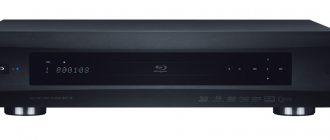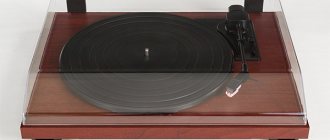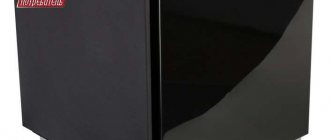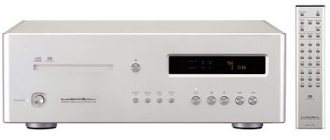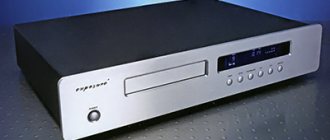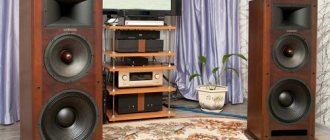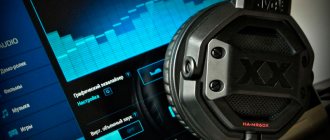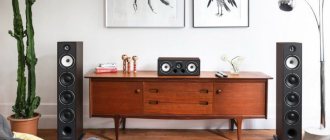Marantz set: SA8005 CD player and PM8005 stereo amplifier, review. Magazine "Stereo & Video"
The overall impression is extreme coherence and no difficulties when processing a signal with steep edges: the sounds of the “kick drum” set into motion almost the entire mass of air in our listening room. It was hard to believe that according to the passport the power of the amplifier is only 70 W/channel. This is what it means to correctly distribute roles!
Save and read later -
Ken Ishiwata is considered the main guru of the Marantz company, but his colleagues can also lay claim to the title of magician - they managed to refute the popular belief that the design reserves of the CD player/full amplifier set have long been exhausted. What is the highlight of the system presented to our experts?
Bearing in mind that ideally a potential buyer should fall in love with his future technology at first sight, Marantz designers have created further miracles of elegance. Yes, the appearance of the devices (by the way, they were made in Japan) has long been familiar to our regular readers - at least from the “pearls of Ken Ishiwata”, the SA-KI-Pearl/PM-KI-Pearl set, which was highly praised in No. 10, 2010. Exactly 4 years have passed (according to Hi-Fi chronology, this is an entire era), but the successfully found decorative solutions are not at all outdated. The aluminum front panel is not solid, as it might seem at first glance. It consists of three parts: a central insert in a champagne splash color and two rounded silver sides. The insert represents the working area. Controls for the main functions are located on it with perfect symmetry. The player has buttons for accessing playback modes (alas, the Eject button is no different from the others; it’s very easy to press it by mistake) and a miniature volume control for the telephone amplifier. Nearby are a 6.3 mm headphone output and a USB port capable of working with FAT16/32 formatted flash cards and HDD drives - the power bus produces a current of up to 1 A. (By the way, the USB port is also compatible with iOS gadgets.) On the back panel there is a promising set of connectors. Immediately striking are the gold-plated RCA jacks of the linear stereo output, widely spaced to avoid mutual interference. The coaxial output and (attention!) digital audio input are equipped with equally high-quality terminals. There is an optical input/output, as well as a USB B port and an external IR sensor input/output (with a corresponding switch). In short, this is a CD player capable of playing the role of an external DAC. In this regard, the ability to install it in a closed rack becomes especially relevant.
|
Under the hood there is no less solid equipment: a powerful power supply with a toroidal transformer and high-capacity capacitors, a low-noise Crystal Semiconductors CS4398 DAC, a high-quality noise conditioner and two low-jitter clock generators. The analog signal amplification path is based on high-speed HDAM SA2 modules with differential input (they also work with a headphone signal). These are actually operational amplifiers, and they - at least in theory - operate over an almost infinite frequency range. Assembled using audiophile-quality discrete components, HDAM SA2 modules are capable, according to the developers, of conveying the finest nuances of SACD recordings, not only from a disc, but also from an external drive or computer. This became possible thanks to the asynchronous USB interface and the presence of a special PC sound card that reads the PCM stream 24 bit/192 kHz and DSD 2.8/5.6 MHz, as well as galvanic isolation of the USB port, which protects against interference from the computer . In addition to electronic ones, mechanical measures are also used to stabilize the work. In particular, the transport mechanism is located precisely at the center of gravity of the housing and is damped so effectively that the rotating disc causes virtually no vibration. The chassis is reinforced with an additional plate at the base, so the weight of the player is no less than 8 kg.
In addition to the mentioned DSD files, MP3, AAC, WMA and WAV recordings (up to 24/192), but not FLAC/ALAC, can be read from discs, solid-state media or iPod. All information is displayed on the fluorescent display on the front panel. The brightness of the display can be reduced, or you can turn it off completely: the readings will be displayed only when a track is selected. There are various playback options - random, according to the program, as well as automatic scanning, which makes it easier to find the desired song (10 from each track are played). There is also a semblance of a Pure Audio mode (disabling digital outputs), as well as Auto Standby - if there is no input signal or the player is in Stop mode for more than 30 minutes, the player will turn off.
|
|
The PM8005 amplifier is in no way inferior to the player in terms of the quality of engineering and design solutions. It’s probably not worth talking about the latter - they are visible, as they say, to the naked eye: the components are in perfect harmony with each other. Meanwhile, if you take a closer look at the front panel of the amplifier, you will be surprised to discover that it is made in a completely different functional key. Unlike the front of the turntable, rotary switches reign here. Not counting the volume control, there are five of them. Four small knobs in the center allow you to change the balance, as well as the timbre of low, high and... mid frequencies (a useful feature for those who often listen to compressed music). The large knob on the left is responsible for selecting the source, and you can’t help but admire the active input indication! Its name is illuminated by a blue LED under a silver insert, and the selection process itself is reminiscent of searching for a station on the dial of a classic analog radio. There is something to be nostalgically delighted about!
The population of the amplifier backplane is numerous and varied. There are screw acoustic terminals for two pairs of speakers, a phono stage input for working with a MM cartridge of a vinyl turntable, five linear stereo inputs and two outputs - adjustable (for what our editors call muscle building, i.e. connecting a power amplifier) and unregulated for recording. An unregulated entrance is also provided. It is activated via the Power Amp Direct button on the front panel, sending the signal directly to the power amp stages. This option will be appreciated by owners of a multi-channel home theater system with an AV processor who want to boost their front speakers using the PM8005. The input/output of an external IR sensor is also not forgotten, so that not only a player, but also an amplifier can be placed in a closed rack.
|
The amplification path is a three-stage circuit assembled on discrete elements with current feedback and the shortest possible signal paths, symmetrical for both channels. Here, as in the player, audiophile quality components are used. The power characteristics of the path have been optimized; for this, engineers had, among other things, to develop a new toroidal transformer with double shielding for the power supply. As a result, the amplifier, according to the developers, is capable of taming the most capricious speakers. To eliminate the microphone effect, the chassis is reinforced with a three-layer metal plate at the base. Another gift for the audiophile is the Source Direct mode. By pressing the corresponding button on the remote control or the front of the amplifier, a lover of “unvarnished sound” will allow the input signal to bypass the tone controls.
|
The main feature of the system - the very highlight that we mentioned at the beginning - is related to the distribution of responsibilities between the components. The player processes digital signals; The amplifier is a purely analog device. And numerous tests in our laboratory indicate that this principle of division of labor is the best. Attempts to introduce digital circuits into an amplifier usually have a detrimental effect on sound quality. Meanwhile, a CD player is a digital device, so to speak, by definition. The DAC is already there, so expanding its functions - for example, introducing the ability to read high-resolution audio files - does not affect the noise immunity of the circuit. In this sense, equipping the player with network functions is somewhat more dangerous, however, judging by the measurement results (see technical commentary), Marantz engineers coped with this task brilliantly. This is confirmed by laboratory listening.
As the main test material, we took the anniversary SACD edition of the album Brothers In Arms by Dire Straits - both on disk and as a DSD file. In the original, this is a multi-channel recording, and the player is not designed to play them, so he had to make a two-channel downmix, the quality of which we really wanted to evaluate. The result exceeded our expectations. The audio stage created by two tight editorial floor-standing speakers has practically not lost any depth, the listener feels the pressure of the bass guitar in the composition So Far Away with his whole body, and the famous saxophone solo from the song Your Latest Trick touches you to tears. The overall impression is extreme coherence and no difficulties when processing a signal with steep edges: the sounds of the “kick drum” set into motion almost the entire mass of air in our listening room. It was hard to believe that according to the passport the power of the amplifier is only 70 W/channel. This is what it means to correctly distribute roles!
| Frequency response of the "player/amplifier" system |
| Frequency response / THD of the player |
| Player output spectrum |
STEREO&VIDEO DATA
Measured in the Stereo&Video laboratory.
October, 2014. SA8005 PLAYER:
- Frequency response unevenness 0.1 dB
- Channel imbalance at 1 kHz (LR) 0.1 dB
- THD at 1 kHz 0,009%
- Peak SOI value 0,0014 %
AMPLIFIER PM8005:
- Output power (0.1% THD, 8 ohms) at 80/1000/10,000 Hz 76.7/75.8/75.4 W
- Damping coefficient 145
- THD at 0.5 P nom at a frequency of 80/1000/10,000 Hz 0,011/0,011/0,015 %
- Frequency response unevenness in the band 20-20,000 Hz 0.3 dB
- Frequency response level at 10/95 kHz -0.1/-2.6 dB
- Upper operating frequency level -0.5/-3/-6 dB 40/>95/>95 kHz
- Channel imbalance -0.2 dB
- Channel separation (LR/RL) 72.2/72.6 dB
A COMMENT
The characteristics of the player are better than those of many premium models, the frequency response fits into a corridor with a width of only 0.1 dB, the channel imbalance is much lower than the audibility level, the SOI is quieter than water in the entire range of audible frequencies (the peak value is only one and a half more than the measured value at 1 kHz times, but in absolute value is negligible). The “carpet” of the output signal spectrum is located at an ultra-low level of -105 dB and has no traces of parasitic harmonics (“frill” at the 20 kHz sweep tone frequency does not count). There are no complaints about the amplifier either. You can grumble about the fact that the tone controls do not change the entire range, but only one frequency (40 Hz, 1 kHz and 11 kHz), but the reproach will be beside the point. More importantly, even at 70 kHz the amplitude decreases by less than 1 dB (the potential of SACD recordings will be fully revealed). By the way, did you notice that there are three humps/dips on the frequency response graph, and not two, as usual? This is due to the presence of a mid-frequency tone control. The measured power exceeds the declared one slightly, however, the user is free to connect any speakers to the amplifier - thanks to the very high damping coefficient.
Prepared based on materials from the magazine “Stereo & Video”, November 2014
www.stereo.ru This review was read 11,855 times
Cambridge CXA60 — RUB 69,990
BEHIND
Immersive sound; rhythm; design; connections.
AGAINST
No USB input.
Released last year
Cambridge's CX series made an impression on us that has not dissipated to this day - not least thanks to the crown jewel of the collection, the RUR 69,990 CXA60 integrated amplifier.
Judging by its recent achievement - extending the Product of the Year title for another year - it remains the best in its segment in terms of price-performance ratio, despite the introduction of the five-star PM6006 (RUB 52,590).
Firmness, texture and sharpness
The iconic bass line in the White Stripes' "Seven Nation Army" is tight, groovy and powerful, and immediately grabs the listener. The groaning and roaring guitar riffs are rich in texture and have an enviable edge, while Jack White's sharp vocals are conveyed in every detail.
Once you listen to the Cambridge sound, it becomes obvious why you pay more for it compared to the Marantz: the electric guitar solo is not only more juicy and powerful, it also has more dynamic variations. However, the Cambridge is disciplined enough to maintain complete control over dynamics and rhythms. The dying notes of the piano at the end of the composition soar above the open musical stage, their lively and exciting sound remains in the memory for a long time.
The “Direct” mode turns off the tone control, preventing its circuits from affecting the sound quality.
The CXA60 is great in every way, except for the lack of a USB port. In this category, it has the most exciting sound and more than decent equipment.
GRADE:
Sound:
Design:
Equipment:
Marantz PM6006 — 52,590 RUR
BEHIND
Meticulousness and expressiveness; many connections.
AGAINST
No USB input.
Hi-Fi components
are fundamentally different from festival tickets, rail concessions and local taxes: if the price goes up or down, there's usually a reason for it. Marantz budget amplifiers used to hit the market for around £300; And we're not without some surprise at the price of the new member of the famous range, which includes the PM6006 (£400) and CD6006 CD player. (In Russia, on the contrary, currency storms led to a decrease in the ruble price).
At first glance, the modifications to the PM6006 over the five-star PM6005 appear to be minor: a second optical input, new “high-performance” feet to reduce vibration, and upgrades to internal components, including the power supply.
Didn't wait
However, it's not the auxiliary digital input we were hoping for. In the review of the previous version, we wrote that a USB port for connecting a laptop would be useful; alas, he is not there now. You can use an optical input and an adapter, but this is still not the best option.
The PM6006 is not a revolutionary new product, however, it is perfect for an entry-level system. However, it has a strong competitor - the Cambridge CXA60.
GRADE:
Sound:
Design:
Equipment:

